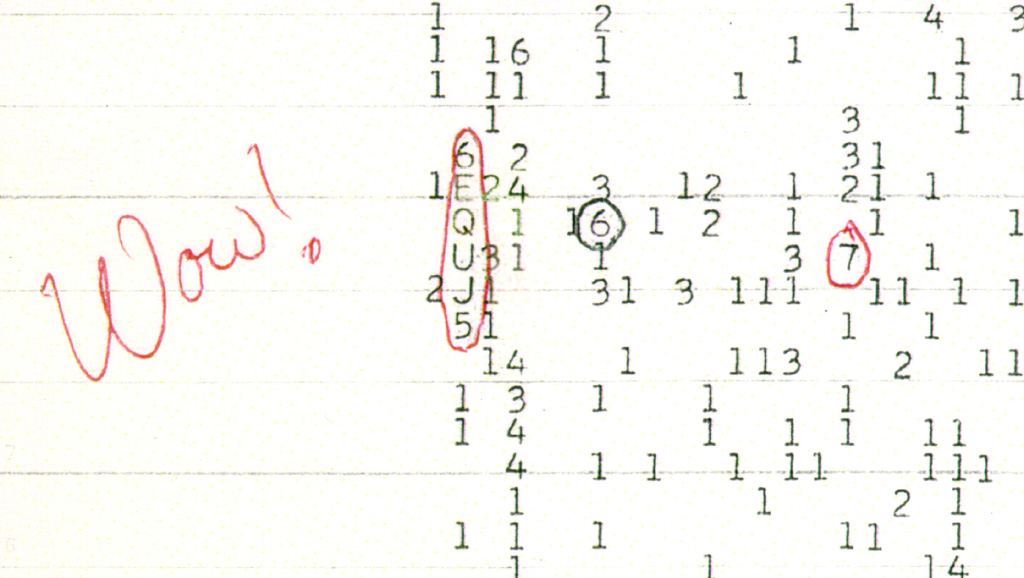Astronomers studying red dwarf stars have spotted something in the background, which they think explains a signal that has been puzzling astronomers since its detection over four decades ago. If they are right, it could represent an opportunity to improve our understanding of rare astronomical events.
In the 1970s, the Big Ear telescope, operated by Ohio State University, was assigned to scan the skies looking for anomalies that might be products of alien civilizations. Looking at a printout collected in 1977, volunteer Jerry Ehman noticed something so odd he circled it and wrote “Wow!” nearby. The 72 seconds of data have been known as the Wow! signal ever since. Although considered unlikely to be the work of aliens, attempts to explain the signal in other ways have generally been considered unsuccessful.
One of the things that makes the Wow! signal so intriguing is that, despite vast growth in the number and power of radio telescopes, we have never seen anything like it. Until now, that is, with a team reporting multiple observations that resemble the original signal, other than being around 60-100 times weaker. A paper describing these findings has yet to pass peer review but is available online as a preprint.

Surely the best-named mystery in astrophysics.
Image credit: Big Ear Radio Observatory and North American AstroPhysical Observatory (NAAPO), Public Domain
Professor Abel Méndez of the University of Puerto Rico searched through archived data from the Arecibo Observatory collected from 2017-2020. The giant telescope was observing nearby red dwarf stars in the hope of learning if their planets might be habitable. In the background behind Teegarden’s Star, the team noticed four intriguing signals, with other examples spotted in two other cases.
“Signal” in this case refers to anything that is not random noise, rather than extraterrestrial communication, as some people may imagine. The signals Méndez and co-authors found are, in their words, “Easily identifiable as due to interstellar clouds of cold hydrogen (HI) in the galaxy.”
Big Ear was looking for signals near the 1420 MHz hydrogen emission line. This is sometimes called “the waterhole”, both because hydrogen is a component of water, and because it is thought civilizations might use this frequency to find each other, like animals at a waterhole. Frequencies around the line are relatively quiet, allowing communication across the galaxy, while hydrogen’s importance makes it a logical place to look.
“Our latest observations, made between February and May 2020, have revealed similar narrowband signals near the hydrogen line, though less intense than the original Wow! Signal,” Méndez said in a statement.
The Wow! signal was distinctive for being brief and only detected in a narrow band of radio frequencies. Both, particularly the latter, are rare for natural astronomical phenomena and expected for alien communication. Méndez and co-authors think the Wow! signal’s surge was the result of a hydrogen cloud being stimulated by something quick, like a magnetar flare.
Nobody made the connection between these and the Wow! Signal before.
Prof Abel Méndez
Activity from neutron stars, of which magnetars are a subtype, was considered as an explanation for the Wow! signal from the beginning. However, the narrowness of the frequencies did not fit, and no suitable object was found on subsequent searches of the area of the sky where the signal was detected. However, a neutron star briefly lighting up a cloud of hydrogen, whose emissions would be in the narrow band Big Ear detected, makes a much more plausible possibility.
“Our signals of cold hydrogen clouds have been known for decades,” Méndez told IFLScience, although they have not been seen often since they need a giant instrument like Arecibo to detect them. However, Méndez added, “Nobody made the connection between these and the Wow! Signal before.” The team only noticed it because they had Arecibo in “drift mode”, as Big Ear was in the original detection, letting astronomical objects pass slowly by.
Big Ear could not have detected a signal as weak as these. It was lucky the Wow! signal was so much brighter. Perhaps such brightness is exceptional but, Méndez noted to IFLScience, “Our signals from clouds could become brighter for minutes to hours due to a strong background radiation source.”
To some extent any explanation of the Wow! signal that does not involve aliens will disappoint many amateurs. However, for professional astronomers this explanation, if confirmed, will be an excellent consolation prize.
Not only will it provide astronomers with something to check when investigating any future suspicious signals, but it could teach us about the behavior of both cold hydrogen clouds and whatever is stimulating them. The preprint notes that within a hydrogen cloud stimulated photons can trigger the emission of additional photons “Leading to a rapid multiplication of photon numbers and consequently a significant increase in intensity.” As a result, we may notice surges in brightness far beyond the original event, alerting us to unusual and important astronomical behavior.
If the explanation is right, the Wow! signal was the first detection of an astronomical hydrogen maser flare, something subsequently detected in 1989 and observed only a few times since. Masers are lasers whose radiation is a microwave wavelength.
Even when astronomical hydrogen masers have been seen, they have occurred at emission lines other than 1420 MHz, so this would still be the only astronomical maser at that frequency. However, 1420 MHz masers have been produced in laboratories, so we know they are possible.
With Arecibo now sadly collapsed, the red dwarf planet project continues with a much smaller instrument.
The yet to be peer-reviewed report is available as a preprint on ArXiv.org.
Source Link: Iconic Wow! Signal May Finally Have An Explanation (It’s Still Not Aliens)